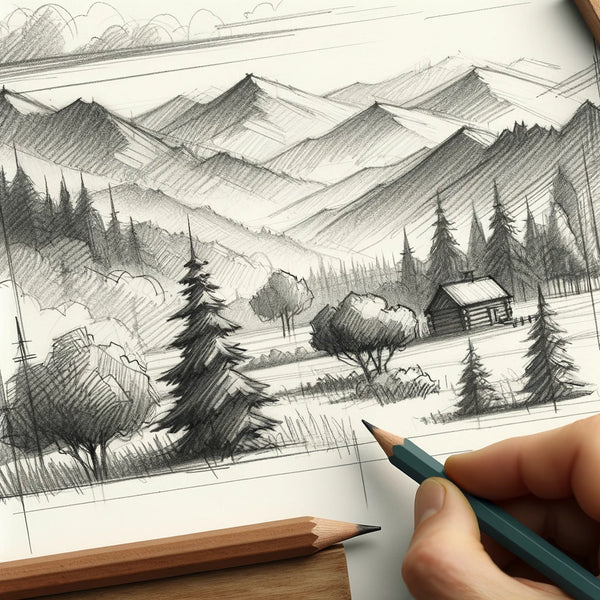Starting your painting journey with scenery offers a wonderful way to express yourself artistically. Whether you're just beginning or have some experience, capturing the beauty of landscapes on canvas is both rewarding and enjoyable. In this guide, we'll take you through simple steps to create beautiful scenery paintings, helping you tap into your creativity and bring the serenity of nature to life.
History About Scenery Painting
Scenery painting, also known as landscape painting, has a rich and varied history dating back centuries. While landscapes have been depicted in art since ancient times, it wasn't until the Renaissance period in Europe that scenery painting emerged as a distinct genre. During this time, artists began to explore the natural world with a newfound appreciation for its beauty and majesty.

In the 17th century, Dutch landscape painters like Jacob van Ruisdael and Jan van Goyen became renowned for their realistic depictions of the countryside. Their work often showcased serene pastoral scenes, bustling cityscapes, and dramatic seascapes, capturing the essence of the Dutch Golden Age.
During the 19th century, scenery painting underwent further development and diversification. Romantic landscape painters such as J.M.W. Turner and Caspar David Friedrich embraced the sublime, portraying nature as a powerful and awe-inspiring force. Their evocative works evoked a sense of wonder and introspection, inviting viewers to contemplate the beauty and mystery of the natural world.
In the 19th and 20th centuries, the Impressionist movement revolutionized scenery painting with its emphasis on capturing the fleeting effects of light and atmosphere. Artists like Claude Monet, Pierre-Auguste Renoir, and Camille Pissarro broke away from traditional techniques, opting instead for loose brushwork and vibrant colors to convey the essence of a scene.
Today, scenery painting continues to thrive as artists draw inspiration from both the natural world and their own imagination. Whether working en plein air or in the studio, contemporary landscape painters explore a wide range of styles and techniques, from realism to abstraction, creating artworks that reflect their unique vision of the world around them.
Why Painting Scenery?
Painting scenery holds a special allure for artists, offering a multitude of reasons why they are compelled to depict the natural world on canvas. Firstly, painting scenery allows artists to capture the beauty and tranquility of the outdoors. From lush forests and sprawling meadows to serene lakes and majestic mountains, landscapes provide a rich tapestry of colors, shapes, and textures to explore.
Moreover, painting scenery provides artists with an opportunity to immerse themselves in nature and experience a sense of peace and connection with the environment. Many artists find solace and inspiration in the act of painting outdoors, known as plein air painting, as it allows them to escape the confines of the studio and experience the sights, sounds, and smells of the natural world firsthand.
Additionally, painting scenery offers a creative challenge for artists, requiring them to interpret and translate the ever-changing light, atmosphere, and mood of outdoor scenes onto canvas. This challenge encourages artists to develop their observational skills, experiment with different techniques, and push the boundaries of their artistic abilities.
Furthermore, painting scenery allows artists to preserve and commemorate their experiences in nature, capturing fleeting moments and immortalizing them in paint. Whether it's a breathtaking sunset, a tranquil woodland path, or a rugged coastline, landscape paintings serve as visual records of the artist's encounters with the natural world.
How to Paint Scenery
Painting scenery can be a fulfilling and enjoyable artistic endeavor. Whether you're a beginner or an experienced artist, capturing the beauty of nature on canvas can be a rewarding experience. Here are some simple steps to help you paint scenery:
-
Sketch the Composition

Lightly outline the main elements of your landscape using a pencil. Include the horizon line, mountains, trees, and any focal points you want to include.
-
Block In Background

Start by painting the background elements such as the sky and distant mountains. Use light, muted colors and a large brush to create a smooth gradient.
-
Add Middle Ground Elements

Move on to painting middle ground elements like trees and bushes. Use slightly darker colors and a smaller brush to add details and depth.
-
Work on the Foreground

Paint the foreground elements like grass, rocks, or water. Use darker colors and add texture to create a sense of depth and perspective.
-
Final Touches

Once the paint is dry, add final details and highlights to enhance your scenery. Pay attention to light and shadow to make your painting more realistic.
Remember, painting scenery is a journey, and each painting is an opportunity for growth and expression. Don't be discouraged by mistakes or setbacks; embrace them as learning experiences and keep experimenting and exploring your creativity. With practice and patience, you'll continue to improve and create beautiful works of art. So, why not share your scenic creations with us? We'd love to see how you've captured the beauty of the world around you on canvas.
Also read: What Skills Are Needed to Draw?

